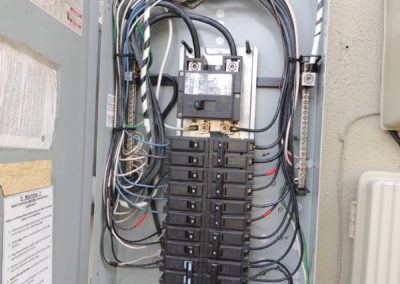
Our Solar Home
We live in Florida, our home faces due south, my roof has a 20-degree pitch, and I’m an electrical engineer. Yep, the stars aligned and in 2016 I determined solar energy had now become cost-effective. Beyond just design, there is a lot of work involved if you’re going to do it yourself, especially when you consider the panels I chose are 6.4 feet tall each and there’s 25 of them. (Yup, that’s Greg standing next to a stack of them in front of our garage). But, that’s exactly what I did. I designed it and installed it myself. It was work, but it’s really not difficult and I feel anyone who is handy and has a reliable mentor can easily do it. It’s perfectly legal, and you can pull the permits yourself.
Welcome to Florida
Ah, the Sunshine State. A generally conservative state (politically), which you’d expect defends freedom from over-reaching government controlling your life, and protecting your rights to be self-supportive; right? Yeah, nothing could be further from the truth. In fact, Florida is the second most hostile state against private solar energy behind Nevada. It’s interesting that Florida actually has a law on the books where no residential home may be disconnected from the public power grid, and if you do your certificate of occupancy will be revoked. And the State used that law as recently as 2016 in a court battle to force a retired woman, in her self-sustaining solar/battery home, to reconnect to the grid.
Florida power companies also collaborated with State government to approve a minimum power usage fee in addition to the $18 service fee everybody already pays to maintain and repair the public grid, that is if you consume less than $30 worth of electricity, your minimum charge will always be $30 – but only if you have solar panels on your home.
In 2021, the Florida Power companies managed to get a bill through Florida State Legislature that was aimed at eliminating solar net-metering altogether, and charging only those customers with solar panels a surchrge. FL House Bill 741 passed the house with 68% of the vote, however Gov. Ron Desantis vetod the bill on April 27th, 2022. That bill now returns to the House where the Florida power companies have vowed to restructure the Bill and try again. The Bill was founded on the outdated rhetoric that customers with solar panels who use less electricity are driving the cost up for those that don’t have solar and use more. This is a lot like saying that people who chose to go on a diet and eat less food are driving the food costs up for those that don’t diet – because someone has to pay for the cost to deliver that food.
If you take a long look at the numbers, what’s really happening is an economic shift. The cost of solar energy is coming down while the cost of producing energy using other fuel sources is rising. When you graph out the math, the curve for solar is crossing an economic threshold. Regardless of politics, I ignore the rhetoric and continue with determination. Math doesn’t lie.
Electricity isn't the only thing
Florida means hurricanes, and that means designing a system to meet Miami-Dade wind mitigation regulations. I had to calculate both positive and negative wind loading at three angles. But this also led to another discovery – I should calculate the thermal loading, or as it turns out – the thermal load reduction. Less sun hitting my roof means less heat in the home; a lot less.
Each square foot of Florida sun shines 15 watts of radiational energy or 51.15 BTUs. Each panel is 20.8 sq-ft and there are 25 of them. That’s 26,598 fewer BTUs per peak hour heating my attic crawlspace.
Here Comes The Sun
This little video slide show takes us through from beginning to end.
Numbers Don’t Lie
1. Total Cost
My total cost for materials was $15,200. That’s for a 8.5 KW peak system. I took one week of vacation time and installed the system in 5 days on my own.
2. Return on Investment
Before Solar, my electric bill averaged $245 every month. Now it averages $30, the minimum charge from Duke Energy even if you don’t use any of their power. Under perfect (impossible) conditions it would take 5.1 years to break even. I calculated 6.5 years, given cloudy days and winter sun angles. In reality, we broke even at 6.2 years. Every watt after March 12, 2022 is a gain.
3. Longevity
The panels have a 30-year warranty, the electronics a 25-year warranty. The panels degrade 1% in efficiency each year, but level out somewhere around 80% (20 years). Remember, we have satellites in orbit still running on solar panels that are 70 years old. Since I’m a little over 50, I can live with those numbers.
4. At My House, Only My Family Matters
Don’t care what others think, I walk my own path. With retirement little more than a decade away, one less utility bill (more-or-less) is part of our planned future.

















